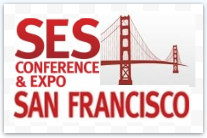SEO 2.0: Less is More
Moderator: Danny Goodwin, Associate Editor, Search Engine Watch
Speakers:
Dr. Horst Joepen, CEO, Searchmetrics
David Naylor, SEO, Bronco
The long awaited Day 3 has arrived. It’s a bit early for some of these folks but it looks like quite a few have managed to drag themselves here, all carrying their coffees of course! I made it early and was teased by the badge scanner lady. Hey, early bird gets the worm – or in this case, she got the last plug on the power strip.
I sure seem to be hitting all of Dave Naylor’s sessions. No no, I don’t believe that I have a crush on him, just on his chosen topics of speaking.
Danny opens the session congratulating everyone for making it out early because it was probably hard for some folks. Guess everyone is draggin’ today.
We are going to start off with Dr. Horst Joepen and get some great tips about Panda and Web 2.0. Then Dave will be given the mic to “go off on whatever he’s going to go off on.”
Horst asks if anyone from Google is in the room. Nope, no answer, just crickets. He tells a story about how Google rolled out Panda when they were moving offices…not good timing, that’s for sure. Lended itself to late nights for them.
Horst’s presentation is called SEO 2.0 – Walk the Line. Jumping into his presentation, he talks about Google’s most noticed penalties. 2006 – BMW, 2009 Vince + Canonical, 2010 Mayday and Brand Update, 2011 JCPenney, Overstock and Panda 1.0 (U.S. only), 2.0 (US & international English) & 3.0(pan-English). 2011 was definitely a busy year so far and we’re only 8 months in! What is in store for the rest of the year? I’m slightly scared to ask.
Panda – Auto Penalty or Auto Quality Rating:
Before Panda there were analytics-supported (manual) quality rating and (time-limited) penalties. After, there is permanent quality assessment during crawling/indexing and permanent pressure on keyword positions. This means permanent algorithm improvements.
Horst shows a slide for the performance on ezinemark.com during the Panda updates and there are some dramatic drops at each release. With each release they lost traffic, then were able to recover until 3.0 hit and they bottomed out and have not recovered. This illustrates that search position is always under permanent pressure.
Can you detect warning signs that you can look out for?
You need to watch what’s happening in the SERPs that matter to you and see if there is any shifting going on that can send up a flag.
Horst shows a list of French sites that lost heavily during Panda and it shows significant losses in many sites. Of course many of the sites were doing wrong by Google so they deserved to lose. Yes, there were some innocent by-standers unfortunately.
Sites that improved after Panda in France – sites like YouTube, Wikipedia, Facebook etc.
What is interesting in Horst’s presentation is that he is taking a World look at Panda’s reach and how only some sites were able to escape impact in various countries but across the board everyone was hit pretty hard.
He mentions that size matters. If you are a well established site with a lot of traffic, your business may not necessarily be hit as hard by Panda. Your rankings may take a hit but your established traffic may not change that much.
Now to hit on the JCPenney scandal. Horst shows a slide on the traffic from before the scandal until recently. They had about 200k visitors a day. Then their link building campaign took hold and traffic increased until the penalty hit and they lost rankings and traffic. The site slightly recovered until Panda 2.0 and traffic bottomed out again. Since then, their traffic has only returned at a small percentage compared to before. Lesson here kids, spammy link building is not good.
Compensating for lost organic traffic from other sources, is that possible? For many sites Organic traffic is the biggest provider of traffic to a site. When that traffic is lost, your other alternatives will cost you money – PPC is the main replacement option and can be so costly.
Horst suggests watching for penalties in your site’s peer group. Start a regular practice of looking at your search results compared to your competitors. When you see dramatic drops, dig in further to see what was taking place to cause the penalty.
What are the warning signs? Naturally, reasons for penalties will be built into Panda and algorithm improvements. This means that if you haven’t been hit yet but are using similar tactics, you will be hit soon enough.
What to look for:
- What competitor got away and why
- Who got hit and why
- Compare backlink structures- Is anyone doing aggressive link building that could hurt them?
- Compare content and structure of competitor domains
- Compare Adsense and affiliate load
- Compare social network activities
- Compare user experience
Assess who is doing better in the right area and then try to implement changes to mimic that to help safeguard your site against penalties.
In conclusion, who will win with SEO 2.0? Those with original content will win, but the original publisher of the content doesn’t always win. Brands and established businesses are also big winners. And lastly, Google wins because of their reach.
When you are hit with penalties, you need to adjust your SEO strategy. Focus on the long-tail keywords. You can use PPC to target the short-tail keywords. In the worst case scenario you can always re-launch your site.
The take-aways are that the line has been moved up and quality counts even more. Peer group monitoring is more important than ever and you need to learn from the mistakes of others – as well as what others are doing right.
It’s now Dave’s turn to try and help those who have been hit by Panda.
What is SEO 2.0? Is it just a new buzz word or a defined technique? SEO is constantly evolving, and you need to stay ahead of the game and most importantly, think of the changes Google is making.
What’s changed? Universal search and personalization came into play. The rise of social and Google stepping into the social space plus the recent Google updates are also notable changes.
What hasn’t changed? The fact that Google wants you to build sites for USERS and not the search engines. This will probably always be the case.
What was Panda? It wasn’t rocket science – it was common sense. It was getting rid of poor content and poor user experience. It was getting rid of sites that had really bad network links – those who were spammy.
So what is still important? Again, it’s not rocket science. On-page optimization is still important. Having title tags, headings and unique content is still important. Good site structure in coding and speed as well as good on-page linking.
On-page factors that are important: Be worthy for visitors and Google, not just Google. Think more about the long-tail search traffic and then focus on the main terms. You may also want to add in some conversion tracking so that you can more easily optimize for your visitors – enhancing their user experience. In the long run that will be what pays off for your site.
Dave gives a cool analogy of how Panda hits sites with bad linking schemes. It starts at the bottom – the bad page. What pages are linking to it? The bad page gets “pandarized’, then the pages linking to it also get hit by the ‘cancer’ and so on and so forth until the whole site is hit as well as any link related sites. Be smart with your linking and link to good content.
What are some off-page things to think about? The ranking algorithm still heavily weighs towards links. The link landscapes and link profiling is changing. Really analyze sites and pages you are looking at linking to or getting links from. Footprint them and see if they are involved in suspect behavior. If so, steer clear of them because you will get ‘infected’. Mix up your anchor text and linked to page for inbound links. Spy on the competitors to see what they are doing in their link campaigns and take hints from the things they are doing right.
A quick find link is often not one that you really want. The link building that takes a lot of time to score a link are often a higher quality and are the ones you want. Remember, link building is hard and it comes with small rewards. If you are finding it easy, you are probably doing it wrong. Also, be smart about getting links. Put out content or widgets that are link worthy. Create relationships in your industry that can turn into links.
Be smart with your data. Rankings are a moving target and you need to develop new ideas to keep authority. You need to know how to use your data effectively so don’t be afraid to dig into your stats and analyze. Also, don’t be afraid to find new keywords by looking at the untapped traffic streams, conversions and new sources. Think outside of your industry box.
What does SEO 2.0 mean for the future of SEO? To Dave, it’s always been the same. Build sites for the users, not the search engines. Take a more holistic approach and use many different techniques. Build up your brand and dominate 1st page real estate. Build a strong community and interact with users. By building up your brand you can help train people to talk about your company using the terms you desire and this will help your organic rankings.
Dave also talks passionately about how important it is to manage your social media in-house. It’s so important to man those accounts internally so you aren’t sending the wrong message or getting things wrong. Twitter and other social media needs to be managed by humans within the company – not outside marketing companies.
Ways to improve your presence – Blog. The blog adds extra content and personality. Don’t forget to include the Share buttons. But remember, don’t do a blog just to add a blog but do it because you have a reason for it.
Videos & images are also good to have. Create a YouTube channel and include on your site because this is good content for visitors.
Twitter & Facebook presences are important. You need to tweet regularly and update often plus you need to interact.
StumbleUpon and the like will still drive traffic but remember its traffic for traffic’s sake and not necessarily for conversions.
Coupon sites give visitors a reason to visit your site but be careful.
Affiliate schemes, if run smartly can work for you.
Above all else, keep an eye on who’s promoting you.
SEO 2.0 & ranking factors – as Dave says, who knows? No one really knows what the ranking factors are going to be in the future but you need to always be on your toes.
Google+1 may not be a big ranking factor at the moment but in the future it will become a player. It’s a signal of relevance and a vote of trust by the users. Google can spot trends, enhance quality scores and detect interaction etc. Keep this in mind at all times.
Social media activity can help you rank better. It may not be a direct influence but indirectly it can play a role. Google knows about the retweets and likes on Facebook. Even if the links are nofollows, they still know about them and they probably do count in some way.
Top survival tips:
- Keep learning from Google and what direction they are moving
- Move towards controlling search and social to enhance results
Traditional SEO is still needed. You still need to target and focus on main traffic terms for visitors. Focus on good on-page and off-page SEO. Good content will still win these days. It’s worth sharing and people will share it if they know about it. Reduce keyword driven articles titles and remember that your content needs to be engaging for real people. Panda hits sites for publishers like ezine so be aware.
Engaging with your audience is so so important. Get people talking about you and your brand.
Find the right fit for your site and business. Don’t go after all the methods deemed SEO 2.0, but go after the ones that fit the business goals. As you go after those methods, work at them hard and truly put effort into it because going at it half-heartedly won’t pay off completely.
Dave did a great job sticking to his slides and even though a bit rushed at the end, he managed to finish his whole deck without too many tangents. Lots of good tips in this session so take heed and follow their recommendations.

LEAVE A REPLY










